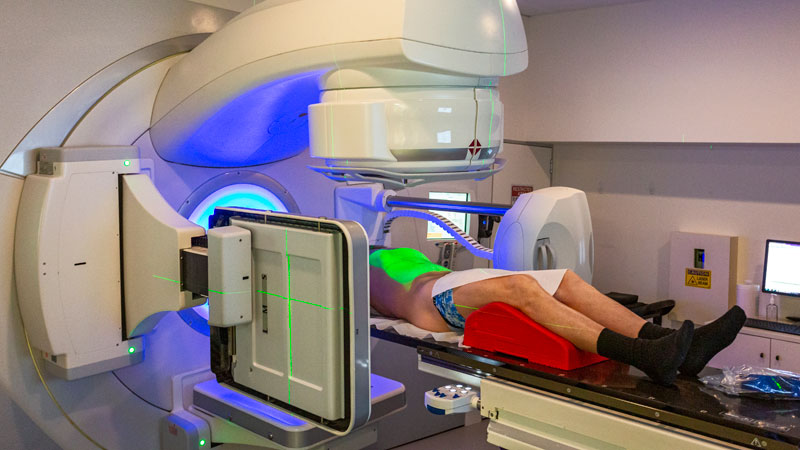HYPORT in Prostate Cancer: New Standard After Surgery? - Medscape

CHICAGO ― The long-term side effects of hypofractionated postoperative prostate bed radiotherapy (HYPORT) for prostate cancer are similar to those of conventional radiotherapy, a new study concludes.
"Hypofractionation is a strategy for shortening treatment by giving larger doses per fraction and is an accepted practice standard for intact prostate cancer," commented the lead author, Mark K. Buyyounouski, MD.
NRG-GU003 is the first study to compare a short course of higher-dose radiotherapy with the well-established, standard 7-week course of radiotherapy for patients who have undergone radical prostatectomy, he noted.
The results showed no clinically or statistically significant differences between the two treatments on the Expanded Prostate Cancer Index Composite (EPIC) with respect to gastrointestinal (GI) or genitourinary (GU) toxicities at 2 years (P = .12).
Although patients who received HYPORT initially experienced more severe symptoms, "those symptoms resolved at 6 months and were identical to the other group ― and stayed that way until the end of the study," Buyyounouski commented. He is a professor of radiation oncology and director of genitourinary cancers in the Department of Radiation Oncology at Stanford University's School of Medicine, in Stanford, California.
"HYPORT is a new acceptable practice standard for patients receiving post-prostatectomy radiotherapy," he concluded.
There are advantages with this approach for all parties, he said. For patients, it requires a shorter time commitment, and there is less expense related to travel and co-pays. For healthcare practitioners, productivity is improved, and costs are lower.
The new study was presented here at the plenary session of the American Society for Radiation Oncology (ASTRO) 2021 Annual Meeting.
Practice Changing or Not?
"These findings are potentially practice changing," commented Sophia Kamran, MD, a radiation oncologist at the Massachusetts General Hospital Cancer Center and assistant professor of radiation oncology at Harvard Medical School, Boston, Massachusetts. She was speaking during an ASTRO press briefing at which the new results were highlighted.
"The field is moving toward hypofractionated radiotherapy for prostate cancer, and it really has been widely accepted in the intact setting," she commented. Now it should also be accepted in the post-prostatectomy setting, she suggested.
"Using contemporary radiation techniques and image guidance, we are able to target a volume and are able to safely deliver hypofractionated radiation therapy that allows for multiple benefits on multiple fronts for our patients, and for our physicians as well," she said.
However, the invited discussant at the plenary session said that more data are needed.
"The information I need before adopting HYPORT as a gold standard is longer-term recurrence data, long-term GU/GI toxicity data, and evidence in higher-risk patient populations that approximate current practice/treatment patterns," said Brendan Mahal, MD. He is an assistant professor of radiation oncology at the University of Miami Miller School of Medicine–Sylvester Comprehensive Cancer Center, Miami, Florida.
"Evidence in settings where lymph nodes are being treated and ADT [androgen-deprivation therapy] is being used is also needed," he added.
That said, Mahal noted that the data from the NRG-GU003 trial could help reduce barriers to post-prostectomy radiotherapy. "It could improve access to potentially curative therapy and reduce financial toxicity and time toxicity, and it could possibly also increase adherence to radiation therapy completion," he said.
As for his own clinical practice, Mahal explained that he would consider using HYPORT in select favorable patients in cases in which lymph nodes are not being treated and for patients for whom longer-course radiotherapy would create a barrier to potentially curative therapy.
"Patients should be counseled about an increased risk of GI symptoms at the end of radiation therapy and the potential risk of radiation cystitis," he added, "and also about the relatively unknown long-term/late GU/GI side effects, given the limited follow-up, and the unknown long-term cancer control."
The reported results are findings at 24 months post radiotherapy.
Noninferiority to Conventional Approach
NRG-GU003 was a noninferiority trial conducted in 296 men who had undergone prostatectomy. The patients were randomly assigned to receive either HYPORT (n = 144) or conventional treatment (n = 152).
With HYPORT, 62.5 Gy was administered to the prostate bed in 25 fractions of 2.5 Gy. Patients who underwent conventional radiotherapy received 66.6 Gy in 37 fractions of 1.8 Gy.
Radiotherapy to lymph nodes was not permitted; ADT of ≤6 months was allowed.
The co-primary endpoints were change in scores (24-month score minus baseline score) from the GU and GI domains of the EPIC questionnaire.
The authors found that compliance with EPIC was 100% at baseline, 83% at the end of treatment, 77% at 6 months, 78% at 12 months, and 73% at 24 months. Buyyounouski noted that at the end of radiotherapy, the mean changes in GU scores in both groups were neither clinically significant nor statistically significantly different and that the scores remained this way at 6 and 12 months following treatment.
However, there was a difference at the conclusion of radiotherapy. The mean change in GI scores was both clinically and statistically significantly different (HYPORT mean GI score = 15.0; conventional therapy mean GI score = 6.8; P = .01).
These differences were resolved by 6 and 12 months, and the 24-month mean changes in GU and GI scores for both cohorts were neither clinically nor statistically significant (HYPORT mean GU score = -5.2; conventional mean GU score = -3.0; P = .81; HYPORT mean GI score = -2.2; conventional mean GI = -1.5; P = .12).
Two years after treatment, there were no differences between the two groups with regard to biochemical failure or local failure.
The study was funded by the National Cancer Institute. Buyyounouski has relationships with Elsevier and Varian. Mahl has disclosed no relevant financial relationships
American Society for Radiation Oncology (ASTRO) 2021 Annual Meeting: Abstract 3. Presented October 25, 2021.
For more news, follow Medscape on Facebook, Twitter, Instagram, and YouTube.



Comments
Post a Comment